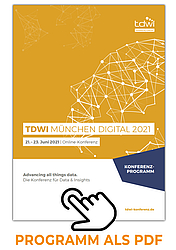
PROGRAMM
Die im Konferenzprogramm der TDWI München digital 2021 angegebenen Uhrzeiten entsprechen der Central European Time (CET).
Per Klick auf "VORTRAG MERKEN" innerhalb der Vortragsbeschreibungen können Sie sich Ihren eigenen Zeitplan zusammenstellen. Sie können diesen über das Symbol in der rechten oberen Ecke jederzeit einsehen.
Für alle, die eine alternative Darstellung bevorzugen bieten wir unser Programm-PDF an:
» Zum PDF-Download
Gerne können Sie die Konferenzprogramm auch mit Ihren Kollegen und/oder über Social Media teilen.
Track: Keynote
- Montag
21.06. - Dienstag
22.06. - Mittwoch
23.06.
For the work we do in the long-term-vision-labs and strategy team for the Technology & Innovation board area at SAP is one of the playgrounds for the title question. These topics are good, because they generate exiting and abundant questions, that we believe should be asked by everyone.
How does the future work, the mechanics of change? What is the future of human work and our interactions with machines and each other? Is industrialization of space and 3d printed organs really a “thing” and how…
Mit der „Berliner Erklärung“ haben sich die EU Staaten zu einer wertebasierten digitalen Verwaltung verpflichtet. Die Bundesregierung nimmt sich mit ihrer Datenstrategie dieser Aufgabe an und will den Staat zum Vorreiter für Digitale Souveränität und Open Data machen. Das 2. Open Data Gesetz und das Dashboard Deutschland haben dazu bereits den Weg geebnet und weiten das Daten- und Informationsangebot des Bundes aus. In weiteren Schritten soll die Nutzung der Daten über Datencockpits und…
The engagement of IT staff in organizations has been done for decades via a single function or department. Whatever title it bears, the single counter IT takes care of everything under the digital sun. This model generates unhealthy behaviors in the IT ranks that are detrimental to the enterprises that need digital to operate, evolve, transform —or survive.
Drawing a parallel with a more mature industry, the current distribution of roles is analyzed and compared. It shows that the standard…

